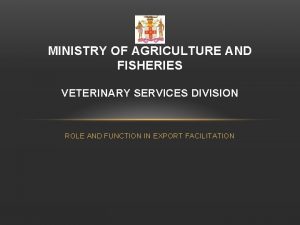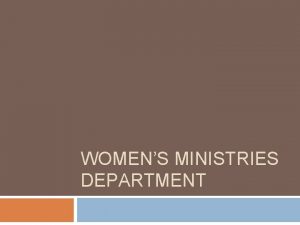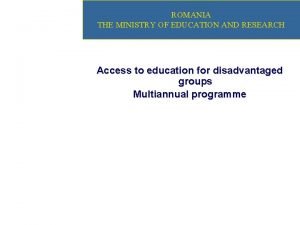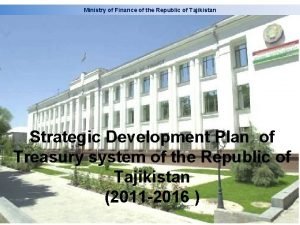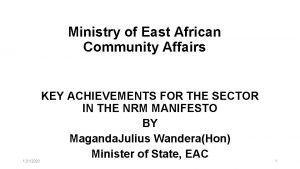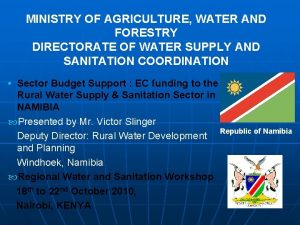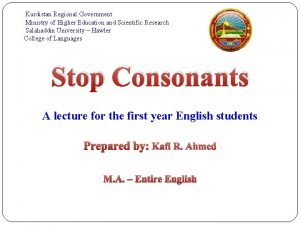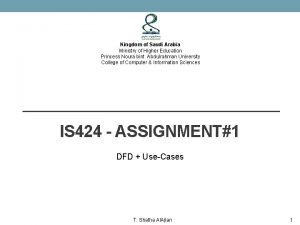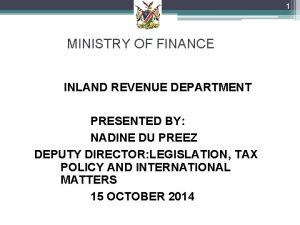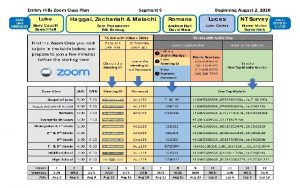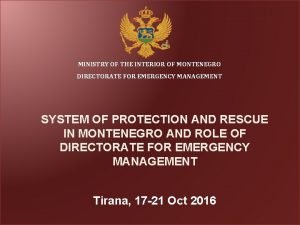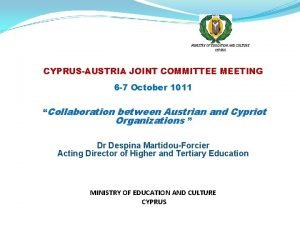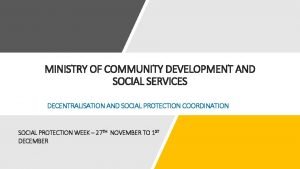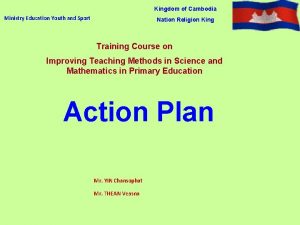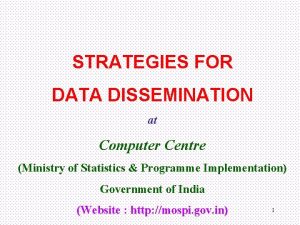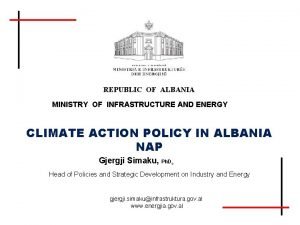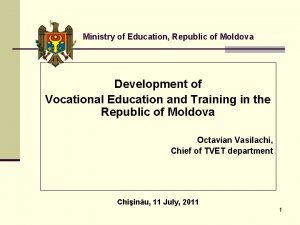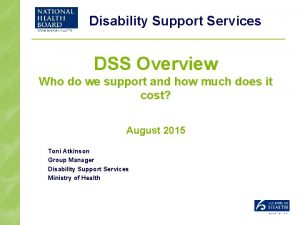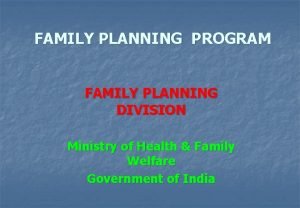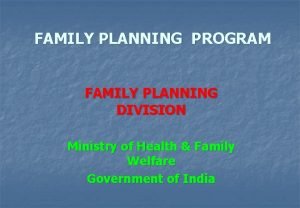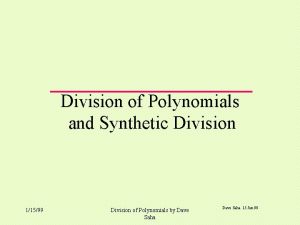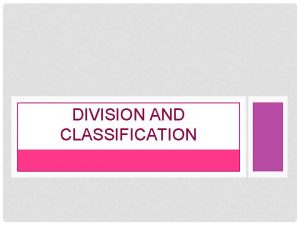FAMILY PLANNING PROGRAM FAMILY PLANNING DIVISION Ministry of










































































- Slides: 74

FAMILY PLANNING PROGRAM FAMILY PLANNING DIVISION Ministry of Health & Family Welfare Government of India

SITUATION ANALYSIS

3

DEMOGRAPHIC SCENARIO 1. India is the second most populous country in the world. 2. India has 17 % of world’s population and has less than 3% of earth’s land area. 3. While the global population has increased 3 times, India has increased its population 5 times during the last century. 4. India’s population is expected to exceed that of China before 2030 to become the most populous country in the world. 4

DEMOGRAPHIC TRANSITION 1. India is in the middle of demographic transition. 2. Both fertility and mortality are declining, (the pace and magnitude of the decline varies across the States. ) 3. Reasons for high growth rate are. : a) b) c) Large size of population in the reproductive age group High fertility due to unmet needs for contraception High intended fertility due to high IMR 5

Performance of Family Welfare Programme Indicators Crude Birth Rate (per thousand population) 40. 8 (1951) Current level 23. 5 (2006) Crude Death Rate (per thousand population) 25. 1 (1951) 7. 5 (2006) Infant Mortality Rate (per thousand) LIVE births) 146 (1951 -61) 57 (2006) Maternal Mortality Ratio (per 100000 live births) 437 (1992 -93) 301 (2001 -03) Total Fertility Rate (per woman) 6. 0 (1951) 2. 8 (2006) 1951: 37. 1 36. 1 (2001) 63. 87 6 66. 91 Life Expectancy at Birth (in years) Male Female Past level

7

GOALS AND CURRENT STATUS Indicator Infant Mortality Rate (per 1000 live births) Maternal Mortality Rate (per 100, 000 live births) Total Fertility Rate Current Level 10 th Plan 2007 2010 goals as per NPP 58 (SRS) 57 (NFHS-III) 45 30 301 (SRS) 200 100 2. 87 (SRS) 2. 7 (NFHS-III) 2. 3 2. 1 8

PROJECTED TOTAL POPULATION AS ON 1 st MARCH 2001 -2026 (IN MILLION) STATES Rajasthan 2001 2006 2011 2016 2021 2026 57 62 68 73 78 82 166 183 201 218 235 249 Bihar 83 91 98 104 109 114 MP 60 66 72 78 83 88 1029 1112 1193 1269 1340 1400 Uttar Pradesh India 9

10

POPULATION PROJECTION 1. India’s population is expected to reach 1. 40 billion by 2026 2. All India Total fertility rate is expected to reach replacement level by 2021 3. The slow pace of fertility transition in UP, Bihar, MP, Rajasthan, Jharkhand, and Chhattisgarh is a cause for concern. 11

Age Composition v Population under 15 years (currently 35%) is projected to decline to 23% by 2026 v v The age group 15 -59 years (currently 58%) is projected to increase to 64% by 2026 Elder persons (age 60 and above) 7% of population in 2001 is projected to increase to 12% of population in 2026 12

WHAT IS TFR n n n The total fertility rate is the average number of children a woman would have if she were to pass through her reproductive years bearing children at the same rates as the women now in each age group. It is computed by summing the age specific fertility rates for all ages. It gives a magnitude of completed family size In simple terms TFR denotes the average number of children borne per woman 13

14

PROJECTED LEVELS OF TFR, INDIA, 2001 -2025 Weighted Estimates Year/Period Unweighted Estimates SRS 2000 3. 2 2001 -2005 2. 82 2. 90 2006 -2010 2. 48 2. 60 2011 -2015 2. 21 2. 35 2016 -2020 2. 01 2. 17 2021 -2025 1. 89 2. 02 15

YEAR BY WHICH TFR OF 2. 1 WILL BE ACHIEVED 1 Andhra Pradesh Achieved in 2005 2 Assam 2019 3 Bihar 2021 4 Chhattisgarh 2022 5 Delhi Achieved in 2001 6 Gujarat 2012 7 Haryana 2012 8 Himachal Pradesh Achieved in 2002 9 Jammu & Kashmir 10 Jharkhand 2018 11 Karnataka Achieved in 2006 12 Kerala Achieved in 1988 13 Madhya Pradesh 2025 14 Maharashtra Achieved in 2006 15 Orissa 2010 16 Punjab Achieved in 2005 17 Rajasthan 2021 18 Uttar Pradesh 2027 19 Uttaranchal 2022 20 Tamil Nadu Achieved in 2000 21 West Bengal Achieved in 2005 22 North-East (Excl. Assam) 2025 India 2015 India (Weighted) 2021 16

17

Achieving the Fertility Goals Help Reduce Child and Maternal Mortality 1. 2. Today there are many high risk births High-risk births lead to high child mortality 18

Reasons for high infant & child mortality n n Short birth intervals n A child born within 1½ yrs. of the previous sibling will have 3 times the chance of dying than after a 3 yr. interval n Leads to malnutrition in children, n Leads to 50% of child deaths. Unwanted children are more likely to die than wanted ones (ref. UNFPA) and n 75% pregnancies are unplanned and n 25% are unwanted in our country (NFHS) 19

High-Risk Births Also Contribute to High MMR In Bangladesh MMR is higher for higher order births … Source: Chen et al. Maternal Mortality in Rural Bangladesh Studies in Family Planning 5: 11; 334 -341. 20

High-Risk Births Also Contribute to High MMR … and higher for older mothers. Source: Chen et al. Maternal Mortality in Rural Bangladesh Studies in Family Planning 5: 11; 334 -341. 21

Achieving the TFR goal will reduce the percent of high-risk births … High-risk births are those that are spaced less than 2 years apart, or where the mother is under 20, 22 over 30 or already has 3 children.

Achieving the TFR goal will reduce the percent of high-risk births … n n High fertility n strongly increases a woman’s life time risk of dying from pregnancy related causes. Reductions in TFR n reduce the number and proportion of high-risk births 23

Means of reducing TFR n 25% increase in breastfeeding duration n n would reduce TFR by 11%. (ref. UN-ACC/SCN) Accessible and effective family planning services n reduce maternal deaths by 35% by simply preventing unintended babies being born ( ref. DFID. ) 24

In a single generation Thai fertility moved from high to low levels 25

In a single generation Thailand emerged as a middle-income country Source: World Bank Development Indicators. 26

Declining fertility was a key factor in the Asian economic “miracle”. . . n n Greater emphasis on the quality of the population rather than sheer numbers More and better educational opportunities More investment in modern agriculture Higher levels of savings and investment with lower dependency ratios Source: Population Matters: Demographic Change, Economic Growth, and Poverty in the Developing World. 27

Benefits of family planning n. Stabilises population n. Reduces maternal mortality n Reduces infant and child mortality 28

Benefits of family planning n Frees scarce and vital resources for equitable distribution among the people n Leads to economic upliftment of the people n Improves the quality of life n Leads to all-round progress of the state and the country as a whole 29

Slower rates of population growth benefit all aspects of development Health Education Agriculture Population Economy Environment Urbanisation 30

National Population Policy, 2000 v IMMEDIATE OBJECTIVE Address the unmet needs of contraception, Reproductive and Child Health care v MEDIUM TERM OBJECTIVE Achieve Replacement Level Fertility by 2010 v LONG TERM OBJECTIVE Bring about population stabilisation by 2045 31

WHERE WE STAND NPP 2000 and the present scenario: 1. 2. 3. 2010 Population replacement (put back now to 2021) 2045 Population Stabilization (put back now to 2060 (1. 53 billion in 2060). EAG states constitute 42% of the population (TFR between 3. 4 and 4. 3) 32

NATIONAL RURAL HEALTH MISSION v The Government has launched NRHM that includes the second phase of Reproductive and Child Health (RCH) program. v Population stabilization is one of the objectives of NRHM. v NRHM seeks to provide effective health care through improved access to quality health care services to rural population v NRHM provides a thrust for reduction of child and maternal mortality and fertility rate. 33

AREAS OF CONCERN IN FP ( Socio cultural factors) 1. Large unmet needs for contraception 2. Poor quality of family planning services 3. Inadequate attention on spacing methods 4. Low male participation 5. Low age at marriage for girls 6. Low age at bearing Children 7. Low spacing between pregnancies 8. Frequent pregnancies 9. Strong preference for son 34 10. Low proportion of safe deliveries

Areas of concern in FP (Programmatic weakness) n Poor Access to FP services n n n Poor Manpower development at state level n n n No effort to increase manpower for minilap and lap. Underutilization of trained NSV providers Lack of Contraceptive updates at state/district Lack of Concerted BCC strategy for FP Achieve ELA in the last quarter n n Fixed day regular services unavailable at sub district level 24/7 PHC & FRUs not providing sterilisation services Pressure on the system where quality is a casualty PPP in FP not evident n Non accreditation of private providers at state/distr. 35

Declining performance in FP ( 2006 -07) Methods Tubectomy 2005 -06 45, 26, 690 2006 -07 % change 44, 00, 027 - 3. 0 (approx) Vasectomy 1, 65, 342 1, 14, 065 3. 5 to 2. 5 Total steri. IUD 46, 91, 975 45, 14, 092 - 3. 8 61, 68, 584 59, 45, 859 - 3. 6 36

Major reasons assigned for falling performance n Supreme court’s order of 2005 on qualification norms of doctors performing sterilisation Lack of laparoscopes (40% of sterilisations done are Lap. St. ) (both the above does not explain fall in IUDs) n n Target free approach introduced in 1996 -97 n Reduced thrust on FP in RCH II 37

Indicators (OVI) Unmet need Nfhs 2 Nfhs 3 (in contraception) Total 16 13 Permanent 8 7 Spacing 8 6 38

FAMILY PLANNING INTERVENTIONS

GOI POLICY (Servicing the unmet need) n Based on felt needs of the community TARGET FREE n Children by choice & not chance n n n Equal emphasis on both limiting and spacing methods ELA : Scientific and statistically significant way being formulated for calculating state wise performance level based on unmet need Population stabilization is a priority area of the GOI 40

MEETING UNMET NEEDS 1 Two third Indians want to use contraception 2 There is no scope for coercion 3 Ensure availability of quality RH services 4 Meet the felt needs of couple 5 Enable couple to achieve their RH goals v 41

New Interventions in Family Planning (GOI) 1. 2. 3. 4. 5. 6. 7. 8. 9. 10. Addressing the unmet need in contraception through n Assured delivery of family planning services n Developing skilled manpower for the same Increasing male participation through intensive promotion of NSV Promotion of IUDs as a short & long term spacing method Promotion of Emergency Contraceptive Pills Ensuring quality care in FP services Promoting Public Private Partnerships Revised compensation scheme Family planning insurance scheme Increasing basket of choices Promoting contraception through increased advocacy 42

Temporary (Spacing) Methods n IUD 380 A n EC Pills n OC Pills n CC ( dual purpose condoms) 43

Reduce unmet need in Spacing method (Increasing access and uptake of IUD 380 A) A. Augmenting trained service providers in IUD: 1. 2. 3. 4. 5. ( Alternative training strategy in IUD in 12 pilot states) 5 Master trainers each trained at NIHFW for all the 12 states All 12 states completed their state level master trainers’ TOT 6 states have gone in for district level training Feedback extremely positive Plan for pilot to be extended to all states has been approved B. Introducing Social Marketing/ Social Franchising in IUD being piloted in 3 states- Rajasthan, Gujarat, Bihar (in final stages) 44

Reduce unmet need in Spacing (advantages of IUD 380 A) 10 years’ duration & not 3 years n Can cover reproductive life span in 2 insertions only (25 - 45 yrs. ) n Can potentially replace the sterilization procedures n Can be inserted at subcentre level n ANM/ MOs could be given refresher training n 45

Promotion of EC Pills n n n 2 tabs of 0. 75 mg or 1 tab of 1. 5 mg within 72 hrs of intercourse in the following situations: n Unprotected intercourse n Unplanned intercourse n Failed CC (Nirodh- torn) n Assault/ rape Levonorgesterol only No side effect One time activity to replace MTP Reduces Maternal Mortality by 10 -15% 46

Promotion of Emergency Contraception (Increasing awareness, supply and use of ECPs) 1. Dissemination through Contraceptive Updates for all states 2. Allowing advertisement by private sector – Relaxation of Drugs & Magical Remedies Act on case by case basis allowed by DCGI 47

Reducing unmet need in Terminal method n Assuring service provision through n Fixed day service round the year n Periodic camps n Augmenting trained manpower in n NSV n Minilap n Lap. Ster. 48

Male participation (Why No Scalpel Vasectomy- NSV ? ) 1. 2. Attain population stabilization in a short period Shifting responsibility of family planning from females to males 49

Why NSV ? 6 Ss: - (advantages) n Scalpel less n Stitch less n Safe n Sound n Simple n Short 50

Increasing male participation (High focus on manpower development) SURGICAL FACULTY TRAINING n 7 centres identified n Training started in all centres n 50 batches/ 200 faculty trained till March 31 st DISTRICT TRAINERS’ TRAINING n District TOT for providing 1 district trainer per district. n 263 district trainers trained till date n Punjab, Rajasthan, Haryana, Uttaranchal, HP has been completed n Jharkhand, Chhattisgarh, AP, West Bengal to be completed. NSV PROVIDERS’ TRAINING n States have put up NSV trainings in their PIPs. Reports are awaited from NIHFW and states 51

Tubectomy (If client chooses it after all options have been explained) n Offer minilap because n No postgraduate surgeon/ gynaecologist required n No anesthetist required normally n No pneumoperitoneum (inflating with gas) n Less post operative distress n If client still demands Laparoscopic Tubectomy Offer services routinely at DH, FRU, CHC, BLOCK PHC (wherever OT is available) 52

Camps in tubectomy n n n Should preferably start by 9 AM As the client is fasting since the previous evening Has travelled long distances to reach the camp site and Is dehydrated Has to have 4 hrs post operative observation before being discharged after being rehydrated 53

Ensuring quality care in FP n n The manual on Standards in sterilization has been updated, printed & uploaded on the website. The manual on Quality assurance in sterilization has been updated, printed & uploaded on the website. n Six Regional Dissemination Workshops on the revised Standards and QA manuals held countrywide in 06 -07. 54

Ensuring quality care in FP n n n All states reported to have set up the QACs at state and district levels as per affidavit filed by them in the supreme court Revised extended QAC as per the updated manuals are in place in most of the states. Most states have completed their orientation of the districts for QA 55

Ensuring quality care in FP n Reference manual on IUCD for MOs (revised, printed & distributed countrywide). n n Reference manual on IUCD for Nursing Personnel (revised and printed) Standard Operating Procedures (SOP) (to ensure the quality in camps has been developed for the first time and is in print) n Manual on Emergency Contraceptive Pill (revised & is in print) 56

Revision of rates for compensation scheme for Sterilization Rationale for increase n low loss of wages compensation n low availability of qualified providers n poor access to service especially in remote areas n opportunity cost was high ( high transportation/ other costs) 57

COMPENSATION A. For Public (Govt. ) facilities Breakage of the Compensati on package Acce ptor High focus states VAS. (ALL) 1100 200 TUB. (ALL) 600 Non High focus states VAS. (ALL) Non High focus states Motivat Drugs or and dressin g 150 1100 200 Surgeo n charges Anest hetist Staff nurse OT techni cian/h elper Refresh ment Camp managem ent Total 50 100 - 15 15 10 10 1500 100 75 25 15 15 10 10 1000 50 100 -- 15 15 10 10 1500 TUB (BPL + SC/ST only)) 600 150 100 75 25 15 15 10 10 TUB (APL) 250 100 75 25 15 15 10 10 1000 650 58

COMPENSATION B For Private Facilities: Category High focus states Type of operation Vasectomy (ALL) Tubectomy (ALL) Non High Vasectomy focus (ALL) states Tubectomy (BPL + SC/ST) Facility Motivator Total 1300 1350 200 150 1500 59

Family Planning Insurance Scheme (limit of indemnity) Claims arising out of Sterilization Operation Amount A Death at hospital/ within seven days of discharge Rs. 2, 000/- B Death due to sterilization (8 th – 30 th day from the date of discharge ) Rs. 50, 000/- C D Expenses for treatment of Medical Complications Rs. 25, 000/- Failure of Sterilization Rs. 25, 000/- E Doctors/ Facilities covered for litigations up to 4 cases per year including defence cost Rs. 2, 000/- n n Dissemination meetings conducted for all state officials Public institutions to display boards on the scheme _____________ 60

9. Strengthening contraceptive supply n n n NSV instruments n Revised Specifications prepared in 2006 (on website) n IPC has cleared procurement of 2500 sets n Consignment received and being distributed to states Laparoscopes n Revised Specifications prepared in 2006 (on website) n States asked to procure as per their requirements from central funds as per approved specifications (can place indents with the TNMSC ) ECP supply n Procurement has restarted recently n Requirements from states received and being supplied 61

Expanding Contraceptive range (Increasing basket of choices) n n n Centchroman (Saheli), once a week non steroidal pill, (developed by CDRI, Lucknow in 1992 is now approved by RAC for multi centric study for 3½ years, before introducing in NFWP) Protocol approved Multicentric Study started in Oct ’ 07 at § 31 HRRCs § 3 medical colleges § 3 NGOs (VHAI, PSS, JANANI) 62

Expanding Contraceptive range 1. Injectables n n 2. Implants n 3. Risug n Phase 3 clinical trials on Cyclofem, Net-en have been completed and report presented before Secretary (Health & FW) Protocol developed by ICMR/ NIRRH for phase IV trial before inducting into the NFWP Implanon, a sub dermal implant is presently under clinical trial RISUG, a male intravasal occlusive contraceptive indigenously developed, is in Phase 3 clinical trial 63

10. Promotion of contraception through intensive advocacy Advocacy kit on contraceptives n Expert committee and core committee set up n n All existing material reviewed and updated New materials developed for NSV, IUD 380 A, ECP, OCP All prototypes for n audio, n video and n print (leaflets, flip charts, posters) finalised and passed on to the IEC division for production and distribution to the states (Jan, 08) Dissemination of FP capsule through regional workshops (WHO biennium 08 -09) n n Approval obtained Funding awaited 64

Infertility management n n 10 - 15 % of couples are infertile. Medical, ethical and legal issues involved. Guidelines for ART (Assisted Reproductive Technology) has been prepared in 2005. Draft bill on ART is awaiting legislation. 65

Family Planning Components n Contraception n Conception (infertility management) n Quality Assurance n Accreditation of facilities n Empanelment of providers n Compensation n Insurance 66

Responsibilities of the states/ districts n Increase number of services centres n Availability of services n Accessibility of services n Affordability of services (Upgradaiton of DHs, FRUs, CHCs, PHCs & SCs under NRHM) n Accreditation of private providers (PPP) 67

Responsibilities of the states/ districts Regular fixed day services round the year a) DH b) FRU/CHC c) PHC d) SC - on demand (daily/ weekly) - weekly/fortnightly/monthly - monthly/ bimonthly - (Tubectomy only if OT available) - IUD/ ECP (on demand) Tubectomy: Vasectomy: Wednesday (optional) Saturday (optional) 68

Responsibilities of the states/ districts 1. Ensure at least n One NSV n One Tubectomy n One IUD Surgeon per PHC Provider per SC (ultimate aim) 2. Effect Manpower Rationalization n Manpower Planning (based on ELA) n Manpower Training n Manpower Placement 3. Develop Comprehensive Training Plan for n NSV n Minilap n LTT n IUD n ECP 69

Action at State/Dist. level n n n Appoint Nodal officer for Family Planning for Planning, Implementing, Monitoring, Supervising & Evaluation) Constitute QAC at state level (10 members) & notify Constitute DQAC at dist. level (9 members) & notify Accredit facilities (Public/Private/NGO) Empanelment of doctors (Public/Private/NGO) Half yearly/Quarterly meetings of State/Dist. QAC (minuted) 70

Action at State/Dist. level Orientation of CMOs on n n n NFPIS (National Family Planning Insurance Scheme) Compensation Scheme (Revised) ELA district wise for limiting & spacing methods (based on dist. Unmet Need) Manpower development (district action plan) n NSV (MOs) n Minilap/ LTT (MOs) n IUD (MOs/ SNs/ LHVs/ ANMs) n ECPs (MOs/ SNs/ LHVs/ ANMs/ ASHAs) Contraceptive updates District budget allocation and disbursement Monthly Review of FP performance with CMOs 71

Action at State/Dist. level Display prominently (facility wise) Revised compensation scheme n Family planning insurance scheme n Service availability (district action plan) n Fixed day service calendar n NSV n Minilap/ LTT n IUD n Camp calendar for above n IEC materials on n NSV n IUD n ECPs Budget may be provided accordingly n n 72

Action at State/Dist. level Lay down benchmarks (performance indicators) and Rank Districts n Reward districts n Reward CMOs (state award) n Recommend for national recognition n 73

74
 Ministry of agriculture veterinary services division
Ministry of agriculture veterinary services division Ministry of education secondary engagement program
Ministry of education secondary engagement program Ministry estate planning
Ministry estate planning Ministry of national development planning indonesia
Ministry of national development planning indonesia Short division vs long division
Short division vs long division Synthetic dicision
Synthetic dicision Long division terms
Long division terms Factoring polynomials using synthetic division
Factoring polynomials using synthetic division Long division family
Long division family Youth ministry 101
Youth ministry 101 Women's ministry goals and objectives
Women's ministry goals and objectives Women's ministry goals and objectives
Women's ministry goals and objectives What is personal ministry
What is personal ministry What is spiritual discernment
What is spiritual discernment Threshold ministry
Threshold ministry Ministry of education serbia
Ministry of education serbia Ministry of education kuwait
Ministry of education kuwait Matriculation certificate
Matriculation certificate Ministry of education romania
Ministry of education romania Ministry of education armenia
Ministry of education armenia Jeremiah timeline
Jeremiah timeline Statoil ministry of petroleum and energy
Statoil ministry of petroleum and energy Ukrainian ministry of infrastructure
Ukrainian ministry of infrastructure Ministry of higher education afghanistan
Ministry of higher education afghanistan Ministry of finance of the republic of tajikistan
Ministry of finance of the republic of tajikistan تعليم الخاص مبارك الكبير
تعليم الخاص مبارك الكبير Ministry of east african community affairs uganda
Ministry of east african community affairs uganda Ministry of transport cyprus
Ministry of transport cyprus Ministry of agriculture, water and forestry directorates
Ministry of agriculture, water and forestry directorates Kalakbay youth ministry
Kalakbay youth ministry Ministry of education kurdistan
Ministry of education kurdistan Ministry of higher education kurdistan
Ministry of higher education kurdistan Kurdistan
Kurdistan Ministry of higher education saudi arabia
Ministry of higher education saudi arabia Church of the nazarene global ministry center
Church of the nazarene global ministry center Deeper life bible church netherlands
Deeper life bible church netherlands Seattle university school of theology and ministry
Seattle university school of theology and ministry Han oil angola
Han oil angola Cogic altar workers
Cogic altar workers History of adventist youth
History of adventist youth Ministry of finance inland revenue
Ministry of finance inland revenue Needs of adolescence
Needs of adolescence Personal ministry goals
Personal ministry goals Elijah ministry timeline
Elijah ministry timeline Ministry of justice jordan
Ministry of justice jordan Youth ministry structure
Youth ministry structure Ministry of agriculture serbia
Ministry of agriculture serbia Length of jesus ministry
Length of jesus ministry Ministry of interior montenegro
Ministry of interior montenegro Ministry of education iceland
Ministry of education iceland Ministry of education and culture cyprus
Ministry of education and culture cyprus Ministry of community development and social services
Ministry of community development and social services Ministry of agriculture and rural development cameroon
Ministry of agriculture and rural development cameroon Ministry of national education morocco
Ministry of national education morocco Ministry of youth and sports cambodia
Ministry of youth and sports cambodia Ministry of electronics and information technology
Ministry of electronics and information technology Adventist aids international ministry
Adventist aids international ministry Adventist aids international ministry
Adventist aids international ministry Aaron and hur ministry
Aaron and hur ministry Unit ministry team
Unit ministry team Ministry strategy
Ministry strategy Ministry of statistics and programme implementation
Ministry of statistics and programme implementation Ministry of education
Ministry of education Ministry of agriculture slovenia
Ministry of agriculture slovenia Ministry of agriculture croatia
Ministry of agriculture croatia Ministry of infrastructure and energy
Ministry of infrastructure and energy Ministry of education
Ministry of education Ministry of education peru
Ministry of education peru Ministry of agriculture and rural development vietnam
Ministry of agriculture and rural development vietnam Prison ministry training manual download
Prison ministry training manual download Amanda bleckmann
Amanda bleckmann Jharkhandxxx
Jharkhandxxx Kwadaso nursing training
Kwadaso nursing training What is panchayat
What is panchayat Prayer of hospitality
Prayer of hospitality
